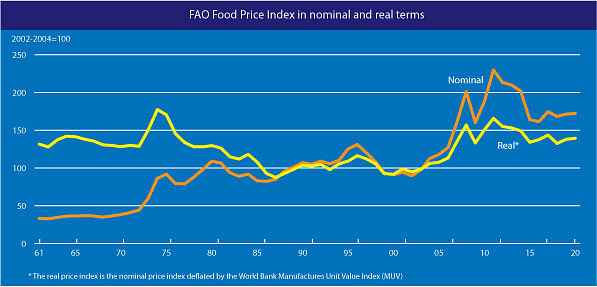The FAO Food Price Index drops to a seventeen-month low
The FAO Food Price Index drops to a seventeen-month low

The FAO Food Price Index* (FFPI) averaged 162.5 points in May 2020, down 3.1 points (1.9 percent) from April and reaching the lowest monthly average since December 2018.
With the continued negative economic effects of COVID-19, the FFPI has been on a downward trend for four consecutive months.
The latest drop in May reflects falling values of all the sub-indices with the exception of sugar, which rose for the first time in three months.
The FAO Cereal Price Index averaged 162.2 points in May, down 1.6 points (1.0 percent) from April and very close to its level in the corresponding month last year. Among major cereals, only rice prices rose in May.
International rice prices edged up 1 percent, mainly on rising Japonica and Basmati quotations, although currency movements and demand from Malaysia and the Philippines also kept Indica quotations firm.
In wheat markets, after a rise in April, export prices fell under downward pressure, shedding almost 2 percent, as expectations point to ample global supplies also in the new season while trade activities have slowed down with the harvesting seasons underway, or approaching, in the northern hemisphere.
In coarse grain markets, the US maize prices, continuing the downward trend of the last four months, fell further in May, to almost 16 percent below the corresponding period last year.
Weak demand from feed and biofuel sectors, amidst abundant export supplies, continued to pressure international maize prices.
The FAO Vegetable Oil Price Index averaged 128.1 points in May, shedding another 3.7 points (or 2.8 percent) and marking a 10-month low. The continued decline of the index primarily reflects lower palm oil prices, whereas quotations of rapeseed and sunflower oils increased.
International palm oil values registered the fourth consecutive monthly drop in May, mainly reflecting protracted, subdued global import demand (tied to the coronavirus pandemic and depressed mineral oil prices) and higher than expected production and inventory levels in major exporting countries.
By contrast, international prices of rapeseed and sunflower oils strengthened owing to, respectively, prospects of continued supply tightness in the EU and shrinking exportable surpluses in the Black Sea region.
The FAO Dairy Price Index averaged 181.8 points in May, down 14.4 points (7.3 percent) from April, registering the third consecutive month of decline and setting the index value 44.3 points (19.6 percent) below its level one year ago.
Quotations for all dairy products represented in the index fell in May, with the steepest drops registered for butter and cheese.
Quotations for butter fell due to large seasonal supplies, especially in Europe, while those of cheese dropped, pressured by lower import demand amid high late-season export supplies from Oceania.
Despite continued high export availabilities and inventories, quotations for whole milk powder (WMP) and skim milk powder (SMP) declined only moderately, as low prices and renewed economic activities in China fuelled strong buying interests.
The FAO Meat Price Index* averaged 168.0 points in May, down 1.3 points (0.8 percent) from April, registering the fifth consecutive monthly decline. At this level, the index is 6.3 points (3.6 percent) below its value in the corresponding month last year and 44 points (20.8 percent) below the peak it reached in August 2014.
In May, international quotations for poultry and pig meats continued to fall, reflecting high export availabilities in major producing countries, despite an increase in import demand in East Asia following the relaxation of COVID-19 social distancing measures.
Ovine meat prices fell slightly due to diminished import demand from the Middle East, caused by economic hardships and logistical difficulties.
By contrast, bovine meat quotations increased on strong import demand amid reduced supplies from Brazil and Oceania, reflecting the start of herd rebuilding phases.
The FAO Sugar Price Index averaged 155.6 points in May, up 10.7 points (7.4% percent) from April. The month-on-month increase of international sugar prices comes largely on the back of lower than expected harvests in some major countries, notably India, the world’s second-largest sugar producer, and Thailand, the world’s second-largest sugar exporter.
Furthermore, higher international prices of crude oil also contributed to the increase in sugar quotations, as higher energy prices tend to encourage sugar mills to use more sugarcane supplies to produce ethanol, reducing sugar availability in the global market. This is notably the case in Brazil, the world’s largest sugar exporter.
















